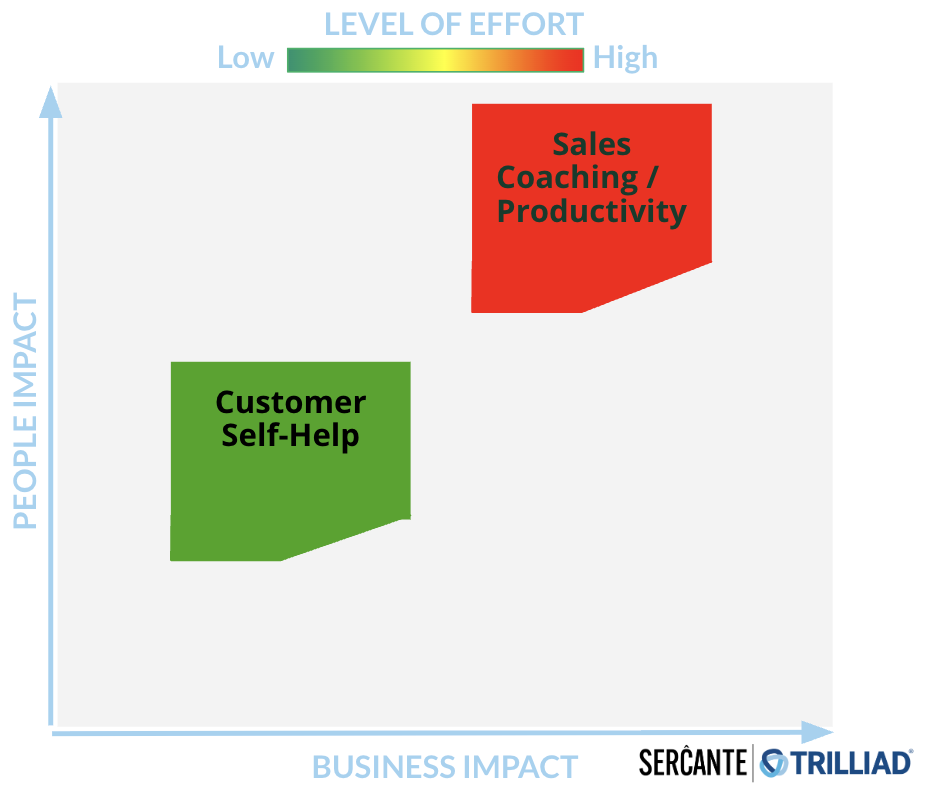If you’re exploring Agentforce or Data Cloud, but feel unsure where to start—or how to ensure real outcomes—you’re not alone. In our recent webinar, “A No-Nonsense Guide to Launching Agentforce & Data Cloud,” we heard from marketing, RevOps pros, admins, and IT professionals across industries who are in the same boat.
The good news? You don’t need to launch a massive initiative to get started. But you do need a strategy. To help guide yours, I’ve shared the key concepts from the webinar where I spoke alongside Sercante’s VP of Growth & Alliances, Lauren Noonan, and Data Cloud Practice Director, Austin Frink, for our proven approach to creating a strategy for Agentforce & Data Cloud that sets you up for success.

Why having a strategy for Agentforce and Data Cloud is imperative
Implementing Agentforce or Data Cloud without a clearly defined strategy is like building a house without blueprints. According to RAND, over 80% of AI initiatives fail—not because the technology doesn’t work, but because teams skip over the foundational work of aligning their tools to real problems, realistic goals, and existing infrastructure.
What we’ve often experienced is that implementing these tools without a clear strategy often exposes existing challenges:
- Data silos become more obvious.
- Misaligned processes are harder to ignore.
- Adoption falters because people don’t see the value.
When we’ve asked organizations about their vision or what they want to accomplish, we’ve heard many who say, “I want an agent” or “I want a unified profile.” While those are great aspirations, they are just starting points. A successful implementation requires more than a desire for automation or consolidated data. It requires a full vision of the why, the what, and the who.
Setting an impactful vision
Instead of focusing on the tool, focus on the challenge, the opportunity, and the people involved.
Ask yourself:
- Why do we want an agent or a unified profile?
- What business challenge are we solving?
- What do we want the agent to actually do? / What will the data be used for?
- How will the data or AI support better decisions?
- Who will benefit, and how?
When considering these questions, be specific. If your starting point is, we want to have better segmentation or to deliver more personalized experiences, dig deeper. What would you like to segment by? Are there specific segments you’re focusing on for a business need? What part of the customer experience would you like to personalize more? Uncovering the more specific needs that lie within will help shape a more actionable vision.
Other questions you can consider for getting started to identify your use cases are:
- Where are the friction points in your customer journey?
- What repetitive tasks are your teams spending time on?
- What segmentation or personalization capabilities are limited by your current data?
Use this framework to build your vision statement. Your vision should capture:
- WHAT: The capabilities you’re adding
- WHY: The impact those capabilities will have
- WHO: The people in your organization who will benefit
This vision becomes your team’s north star. As you outline the use cases for Agentforce and Data Cloud, you will also need to define how they will impact the business.
Anchoring your Agentforce & Data Cloud use cases to business value
Lauren Noonan emphasized during the webinar, that this step is often missed, but it’s key to alignment. The use cases that drive meaningful business value are the ones that sustain momentum and stakeholder support.
To help frame your use cases in terms of the level of impact, consider impact levels such as the following:
- High: Critical to strategic goals or revenue
- Medium: Important contributor to organizational priorities
- Low: Helpful improvements, but not game-changing
For example, one Agentforce use case that would be considered higher impact would be streamlining lead qualification and routing.
Use Case: AI-Powered Lead Qualification & Routing Agent
Scenario: Deploy an Agentforce assistant that engages with inbound demo requests, asks qualifying questions (budget, timeline, decision-maker status), and routes hot leads to the correct rep in real-time based on region, product, or account type.
Why It’s High Value:
- Directly impacts pipeline acceleration and conversion rates
- Reduces lead response time, which is closely tied to revenue performance
- Supports strategic goals around improving sales velocity and rep productivity
- Teams Impacted: Marketing Ops, Sales Development, Revenue Leadership, Prospects, Customers
Notice how the above framing points to impacts such as increased pipeline velocity and speed to lead which leads to higher conversion rates, all tied to revenue.
Medium to low-impact Agentforce use cases might include ones that result in internal efficiency gains, such as streamlining campaign brief creation or surfacing answers to FAQs faster using articles from your knowledge base. However, these lower-impact use cases are often a low-risk and lower level of effort to deploy, so they can be a great starting point as small efficiency gains do add up and free up your team’s time to focus on higher-impact initiatives. Continue to weigh this as you frame your roadmap of priorities.
The other detail to call out from the lead qualification and routing Agentforce example is that it outlined the people who would be impacted. Which is often overlooked, but absolutely necessary when creating your strategy.
Considering the level of impact on your people
Agentforce and Data Cloud aren’t just technical implementations—they’re changes to how people work. According to CIO Dive, 42% of businesses have scrapped most of their AI initiatives in the last year, where studies have shown that the teams that see success are ones that are customizing their use cases and prioritizing them according to their needs and impact. As Lauren shared in her previous article on how to create your AI roadmap, “your unique AI path is the only one that matters.”
You have a unique set of people at your organization with different skill levels, needs, and talents. Not considering a change management plan for how your Agentforce and Data Cloud rollout will be applied will often lead to low adoption rates, causing a low level of success and your initiative to fizzle out.
That’s why it’s so important to assess:
- How will workflows shift?
- What training or enablement will be needed?
- How disruptive will this be to current roles?
Then classify the level of impact on your people:
- High: Many roles and processes change significantly
- Medium: Moderate impact with some changes to roles or responsibilities
- Low: Minimal disruption to current workflows
Evaluating the level of business value alongside the level of impact on your people will help determine which use cases you might want to prioritize first based on the level of effort to deploy.
During the webinar, we showed the chart below as a visualization of the ideal intersection point, which is medium-to-high business impact and low-to-medium people impact, with a lower level of effort to deploy.

The other aspect of your strategy that needs to be considered is the dependencies involved with deploying your use case for Agentforce and Data Cloud.
Understanding your dependencies
As Austin Frink and I emphasized in the webinar: implementation depends on more than just ideas. You need to understand the full picture of what it’ll take to make your use case a reality. That full picture includes the infrastructure that you have, including:
- Technology: What do you already have? Where are the gaps?
- Data: Do you have the right data sources? Are they integrated? Is the quality strong enough?
- People & process: Who owns what? Where will the lift be felt most?
Dependencies aren’t necessarily roadblocks, but more factors that will help you to decide where you might want to start when it comes to implementing technology like Agentforce and Data Cloud.
The last piece to consider when defining your strategy is the metrics you’ll use to measure the impact of your Agentforce and Data Cloud initiative.
Defining your metrics for measurement
Your metrics will be used to help prove the business values that you defined earlier. For every use case, identify one or two key success metrics. Before you start your Agentforce and Data Cloud project, measure where you are right now to get a baseline, so that you can benchmark later on and compare your level of improvement.
Some ideas:
- Customer satisfaction
- Campaign performance
- Churn rate
Ideas of metrics that could be associated with our Agentforce use case example of lead qualification and routing, would be speed to lead, conversion rate, and sales cycle time. If your use case will focus more on efficiency gains, consider the amount of time it takes your team to perform the task without the agent implemented, and then measure the hours of time that are saved as a result.
Pro tip: When bringing your strategy to stakeholders, share what your team will accomplish with the time gained back. This goes beyond just thinking through the metrics, and it will be key when articulating the full picture of the impact that implementing Agentforce and Data Cloud can have on your business.
Common misconception: you don’t need to start with a massive rollout
One of the most common misconceptions when teams are thinking about implementing Agentforce and Data Cloud is that it requires a massive rollout and overhaul. However, this is not the case.
You don’t have to ingest all your data to use Data Cloud. You don’t need to first implement Agentforce into every aspect of your business.
Start with:
- 1–2 use cases
- Lower people impact
- Medium-to-high business value
Clearly defining your use cases will inform you of the data that you’ll need, which will then point to the data sources required. The use case will then point to the agent that you’ll need and the teams or subsect of a department that will be impacted.
As the CMO of Mogli, Christina Scarmeas, shared during her conversation with us about how her team approached implementing Agentforce, “It’s okay to take a crawl, walk, run approach.”

Which is why Sercante service offerings such as an Agentforce Quickstart or Data Cloud In-A-Box are so helpful for teams. They enable you to start small, accelerate time-to-value, and showcase the impact, to then scale the initiative to other areas of the business.
Let’s get started with your approach to Agentforce and Data Cloud
To recap, a successful approach to Agentforce and Data Cloud includes:
- A clear, problem-driven vision
- Use cases tied to real business value
- Understanding the people impact
- Mapping your technology and data dependencies
- Identifying the metrics that will be used to measure impact
Having this all defined will help to serve as your team’s north star to guide a successful approach to Agentforce and Data Cloud.
Now I know how it can be overwhelming to think through all of this, especially with multiple department goals and initiatives, so if you’d like support with creating your Agentforce and Data Cloud strategy, reach out to the Sercante team. We’ll listen to understand your goals, challenges, and help bridge the gap between your vision and reality, for an impactful Agentforce and Data Cloud rollout.









